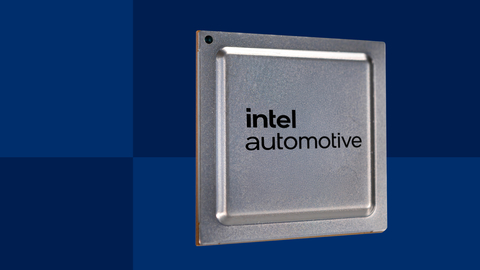Sylvamo Announces Dividend
At CES 2025, Intel unveiled an expanded automotive product portfolio featuring a whole-vehicle platform designed to accelerate the transition to electric and software-defined vehicles (SDVs). The company introduced the Adaptive Control Unit (ACU), specifically designed for EV powertrains and zonal controller applications.
Intel's comprehensive solution includes high-performance compute, discrete graphics, AI, power management, and zonal controller solutions, alongside the Intel® Automotive Virtual Design Environment (VDE) developed in partnership with AWS. The platform aims to address automakers' cost and performance scalability challenges, enabling more efficient SDV development and deployment.
The ACU U310 represents a new processing unit that consolidates multiple real-time, safety-critical, and cybersecure functions into a single chip, reducing the inefficiencies of traditional fragmented vehicle architectures.
Al CES 2025, Intel ha presentato un portafoglio di prodotti automobilistici ampliato, caratterizzato da una piattaforma per veicoli interi progettata per accelerare la transizione verso veicoli elettrici e definiti da software (SDV). L'azienda ha introdotto l'Adaptive Control Unit (ACU), specificamente progettata per i powertrain EV e le applicazioni di controllo zonale.
La soluzione completa di Intel include calcolo ad alte prestazioni, grafica discreta, intelligenza artificiale, gestione dell'energia e soluzioni di controllo zonale, insieme all'Intel® Automotive Virtual Design Environment (VDE) sviluppato in collaborazione con AWS. La piattaforma mira a risolvere le sfide di scalabilità dei costi e delle prestazioni per i produttori di automobili, consentendo uno sviluppo e un'implementazione più efficienti degli SDV.
L'ACU U310 rappresenta una nuova unità di elaborazione che consolida più funzioni critiche in tempo reale, di sicurezza e cibernetiche in un singolo chip, riducendo le inefficienze delle tradizionali architetture automobilistiche frammentate.
En CES 2025, Intel presentó un portafolio de productos automotrices ampliado que incluye una plataforma de vehículo completo diseñada para acelerar la transición hacia vehículos eléctricos y definidos por software (SDV). La compañía introdujo la Adaptive Control Unit (ACU), diseñada específicamente para trenes motrices de vehículos eléctricos y aplicaciones de control zonal.
La solución integral de Intel incluye computación de alto rendimiento, gráficos discretos, inteligencia artificial, gestión de energía y soluciones de control zonal, junto con el Intel® Automotive Virtual Design Environment (VDE) desarrollado en asociación con AWS. La plataforma tiene como objetivo abordar los desafíos de escalabilidad de costos y rendimiento de los fabricantes de automóviles, permitiendo un desarrollo e implementación más eficientes de los SDV.
La ACU U310 representa una nueva unidad de procesamiento que consolida múltiples funciones críticas en tiempo real, de seguridad y cibernéticas en un solo chip, reduciendo las ineficiencias de las arquitecturas automotrices tradicionales fragmentadas.
CES 2025에서 인텔은 전기차 및 소프트웨어 정의 차량(SDV)으로의 전환을 가속화하기 위해 설계된 전체 차량 플랫폼을 포함하는 확장된 자동차 제품 포트폴리오를 공개했습니다. 이 회사는 EV 파워트레인 및 존 제어기 애플리케이션을 위해 특별히 설계된 Adaptive Control Unit (ACU)를 소개했습니다.
인텔의 종합 솔루션은 고성능 컴퓨팅, 디스크리트 그래픽, 인공지능, 전력 관리 및 존 제어기 솔루션을 포함하며, AWS와 협력하여 개발한 Intel® Automotive Virtual Design Environment (VDE)와 함께 제공됩니다. 이 플랫폼은 자동차 제조업체의 비용 및 성능 확장성 문제를 해결하여 SDV 개발 및 배포의 효율성을 높이는 것을 목표로 합니다.
ACU U310은 여러 실시간, 안전-critical, 사이버 보안 기능을 단일 칩으로 통합하는 새로운 처리 장치를 나타내며, 전통적인 분산 차량 아키텍처의 비효율성을 줄입니다.
Au CES 2025, Intel a dévoilé un portefeuille de produits automobiles élargi, comprenant une plateforme pour véhicule entier conçue pour accélérer la transition vers des véhicules électriques et définis par logiciel (SDV). L'entreprise a présenté l'Adaptive Control Unit (ACU), spécialement conçue pour les groupes motopropulseurs EV et les applications de contrôle zonal.
La solution complète d'Intel inclut des calculs haute performance, des graphismes discrets, de l'intelligence artificielle, de la gestion de l'énergie et des solutions de contrôle zonal, ainsi que l'Intel® Automotive Virtual Design Environment (VDE) développé en partenariat avec AWS. La plateforme vise à relever les défis de scalabilité des coûts et des performances auxquels sont confrontés les fabricants automobiles, permettant un développement et un déploiement plus efficaces des SDV.
L'ACU U310 représente une nouvelle unité de traitement qui regroupe plusieurs fonctions critiques en temps réel, de sécurité et de cybersécurité sur une seule puce, réduisant ainsi les inefficacités des architectures de véhicules traditionnelles fragmentées.
Auf der CES 2025 stellte Intel ein erweitertes Produktportfolio für die Automobilindustrie vor, das eine Plattform für das gesamte Fahrzeug umfasst, die den Übergang zu elektrischen und softwaredefinierten Fahrzeugen (SDVs) beschleunigen soll. Das Unternehmen führte die Adaptive Control Unit (ACU) ein, die speziell für EV-Antriebe und zonale Steuerungsanwendungen entwickelt wurde.
Die umfassende Lösung von Intel umfasst Hochleistungsrechner, diskrete Grafiken, KI, Energiemanagement und Lösungen für zonale Steuerungen sowie die Intel® Automotive Virtual Design Environment (VDE), die in Zusammenarbeit mit AWS entwickelt wurde. Die Plattform zielt darauf ab, die Herausforderungen der Kosten- und Leistungs-Skalierbarkeit für Automobilhersteller zu bewältigen und die Entwicklung und Bereitstellung von SDVs effizienter zu gestalten.
Die ACU U310 stellt eine neue Verarbeitungseinheit dar, die mehrere zeitkritische, sicherheitsrelevante und cybersichere Funktionen in einem einzigen Chip konsolidiert und die Ineffizienzen traditioneller fragmentierter Fahrzeugarchitekturen verringert.
- Introduction of new Adaptive Control Unit (ACU) for EV powertrains
- Partnership with AWS for Virtual Design Environment
- Cost reduction through whole-vehicle platform optimization
- Consolidation of multiple functions into single chip solution
- None.
At CES 2025, Intel unveils new adaptive control solution, next-gen discrete graphics and AWS virtual design environment.

At CES on Tuesday, Jan. 7, 2025, Intel introduced the availability of the Adaptive Control Unit (ACU), designed for electric vehicle (EV) power trains and zonal controller applications. The ACU U310 is a new kind of processing unit that supports the consolidation of multiple real-time, safety-critical and cybersecure functions, applications and domains (X-in-1) into a single chip. (Credit: Intel Corporation)
“Intel automotive is bringing innovative solutions that reduce cost in the SDV revolution. Our whole-vehicle approach, combined with cloud integration, delivers a complete solution that drives down total cost of development and deployment while empowering automakers to build the future of mobility faster, more efficiently and more profitably.”
-- Jack Weast, Intel Fellow, vice president and general manager of Intel Automotive
Why a Whole-Vehicle Platform Matters: Intel’s whole-vehicle platform reduces inefficiencies of traditional fragmented approaches to vehicle architectures. By optimizing the entire vehicle’s electrical/electronic architecture, Intel drives significant cost reductions and performance improvements.
Supporting this platform, Intel introduced the availability of the Adaptive Control Unit (ACU), designed for electric vehicle (EV) power trains and zonal controller applications.
About the Adaptive Control Unit: The ACU U310 is a new kind of processing unit that supports the consolidation of multiple real-time, safety-critical and cybersecure functions, applications and domains (X-in-1) into a single chip. Traditional time and sequential processing-based micro and zonal controllers struggle to handle multiple workloads due to limited deterministic processing capabilities. In contrast, Intel’s new family of ACU devices integrates a flexible logic area that offloads real-time control algorithms from the CPU cores, ensuring reliable performance, freedom from interference (FFI) and deterministic data delivery even when consolidating multiple microcontroller workloads into a single zonal MCU. This dual-brain approach enables greater workload consolidation, lowers cost, and enhances safety, cybersecurity and performance.
When used in an electric vehicle power train, the ACU U310 supports advanced algorithmic solutions that reduce vehicle energy demand from the battery, automatically adapting high voltage and control frequencies to individual driver styles and road conditions. The ACU reduces cost per kilowatt and enhances energy efficiency, allowing the vehicle to reclaim up to 40 percent of the power train system energy losses, delivering a
- Stellantis Motorsports selected Intel as a key technology partner and adopting the Adaptive Control technology into its next-generation inverter control for enhanced performance and efficiency in competitive racing environments. In this implementation, the Intel technology will control the electric motor and recover energy during braking phases. The inverter plays a crucial role during a Formula E race, where any gain in efficiency is transformed into a precious competitive advantage.
- Karma Automotive announced support for Intel’s ACU, showcasing an Intel co-branded inverter featuring Optimal Pulse Pattern control algorithms to improve efficiency and enable four unique driving profiles, including innovative features like Torque Ripple Reduction and Range Boost.
The ACU’s programmability allows it to serve as a first-of-its-kind software-defined zonal controller, adapting to different vehicle topologies and applications. This flexibility streamlines the transition to software-defined vehicles, simplifies supply chains and reduces the complexity of the vehicle BOM.
How Next-Gen Architecture is Enhanced with AI Inside: Building on Intel’s first-generation AI-enhanced SDV system-on-chips (SoCs), Intel announced the upcoming second-generation Intel® Arc™ B-series Graphics for Automotive set for production by the end of 2025. This solution provides the high-performance compute needed for more advanced in-vehicle AI workloads, next-generation human-machine interface (HMI) engines, and immersive in-vehicle experiences and AAA PC gaming. Paired with an Intel AI-enhanced SDV SoC, it delivers scalable performance for complex AI tasks, supported by the vast Intel AI ecosystem.
How Intel and AWS Revolutionize Automotive Software Development: Intel and AWS introduced the Intel Automotive Virtual Development Environment on AWS, a groundbreaking approach that ensures true hardware and software parity from cloud to car. This new offering addresses challenges throughout the vehicle development life cycle, enabling engineers to seamlessly switch between virtual and physical hardware setups. It integrates Intel® Xeon® processor-based Amazon EC2 instances and, for the first time, incorporates Intel’s Automotive SDV SoCs within the AWS environment, eliminating the need for expensive electronic control unit (ECU) simulators or developer boards. This collaboration provides a unified solution that accelerates innovation, reduces R&D costs and speeds time-to-market.
About Intel’s System-Level Advantage: Intel's whole-vehicle approach delivers numerous benefits to automakers, including cost reductions, enhanced vehicle performance, streamlined development, improved energy efficiency, seamless AI integration and faster time-to-market – all supported by Intel’s globally balanced supply chain.
More: Intel at CES 2025 | Intel Auto Keynote Explores Software-Defined Future (Video)
About Intel
Intel (Nasdaq: INTC) is an industry leader, creating world-changing technology that enables global progress and enriches lives. Inspired by Moore’s Law, we continuously work to advance the design and manufacturing of semiconductors to help address our customers’ greatest challenges. By embedding intelligence in the cloud, network, edge and every kind of computing device, we unleash the potential of data to transform business and society for the better. To learn more about Intel’s innovations, go to newsroom.intel.com and intel.com.
© Intel Corporation. Intel, the Intel logo, and other Intel marks are trademarks of Intel Corporation or its subsidiaries. Other names and brands may be claimed as the property of others.
View source version on businesswire.com: https://www.businesswire.com/news/home/20250107157568/en/
Marcie Miller
1-480-319-4629
marcie.m.miller@intel.com
Source: Intel Corporation







